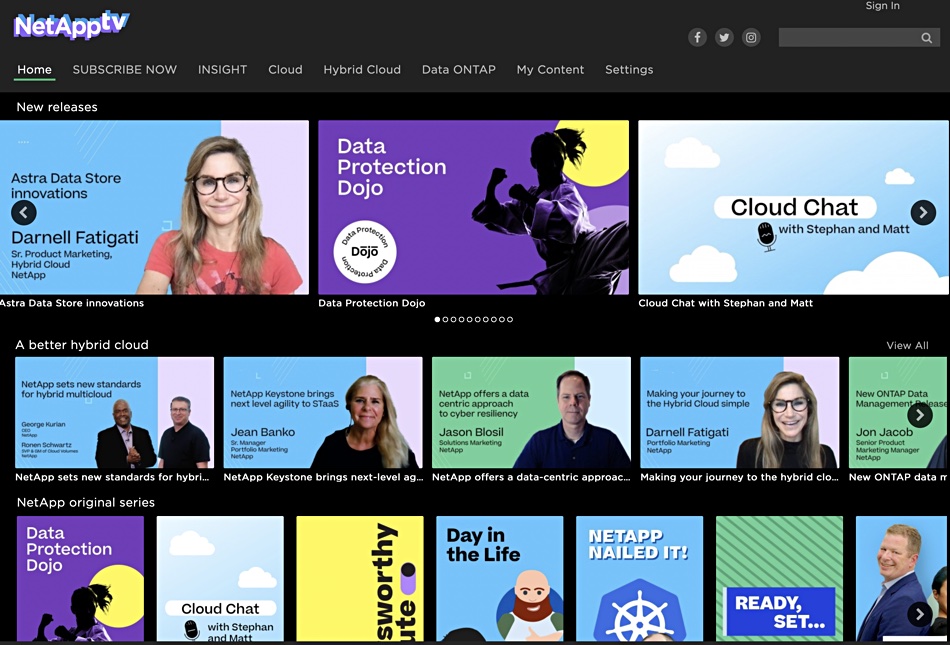NetApp was the first company we cover to start its own in-house TV channel to market its products and strategy. Now HPE has gone one better, in a creative sense, and is producing its own FinTech TV sitcom.
NetApp TV started in 2021 as a streaming TV service in its own right. The company chose to do this rather than use YouTube as a distribution medium, which was the Intel route to getting potential customers to watch corporate content.
Intel’s YouTube presence is subdivided into seven channels and each has content uploaded to it. Here is the Newsroom channel home screen:

Check out the subscriber numbers; that’s one measure of TV channel success. A lot of the videos are short, talking head stuff, one to two minutes long and a bit cheesy. An example: Happy Customer Appreciation Day has CEO Pat Gelsinger thanking customers for their loyalty.
NetApp TV
NetApp is altogether more professional about its TV output. It has its own video website with four channels: Insight, Cloud, Hybrid Cloud, and Data ONTAP.

The programs (videos) are typically two to five minutes long and may form a series, like the five-episode Data Protection Dojo. Think of them as mini-tutorials with a talking head, a NetApp person, introducing a topic and using a few PowerPoint slides as reference points:

They don’t use professional presenters, instead focusing on product managers and product line execs talking about their portfolio areas.
HPE fintech sitcom
But HPE, with Nvidia, has introduced its very own sitcom. “Get Ahead” is a streaming TV production that follows the lives of thee business people involved in applying AI technology to a financial services business; a customer insights manager, a data scientist, and an IT manager.

They are played by professional actors and each of the four episodes in the series is professionally produced, directed, and scripted. Each episode is five to nine minutes long and each is linked to downloadable HPE documentation, such as “An IT Manager’s Guide to Getting Ahead“; PDF brochures to help viewers decide to follow up by contacting HPE.
This strikes us as a highly inventive way to use TV content to get a supplier’s message across to an audience. No talking heads; rather fictionalized real people in real roles meeting real problems in a humorous setting. It was pioneered, we think, by Microsoft in 2017 with a Windows 95 video presented as “the world’s first cyber sitcom,” starring Matthew Perry and Jennifer Aniston.
Why did HPE do this?
HPE told us: “The ambition was to break conformity from traditional AI marketing and challenge the market. The team aimed to convey familiar characteristics and traits of the AI team dynamic highlighting the realities of AI implementation.”
How did the concept originate?
“The idea for the sitcom was based on a qualitative research into the challenges of AI projects within financial services organisations our team conducted. The goal was to create content that conveys the realities of AI implementation and the role-contextual challenges AI teams face.”
Why have three main characters?
“A common theme apparent in all of the interviews was the ‘trifecta’ of roles involved. Participants stated that product managers/line of business, data scientists and IT (IT/data engineers) play a key role in selecting technology and delivering AI projects. Research suggested that these roles often have differing priorities causing friction that can often delay or cause projects to fail. This friction is thought to be a result of different professional characteristics, working methodologies and knowledge of AI in the wider-business context.”
Pure’s video content
Pure Storage, in partnership with Cisco, has produced a cartoon about a character called Francois – who works with the FlashStack converged infrastructure product – and overcoming legacy infrastructure:

It’s 1:20, available on YouTube, and best seen once only. A second episode covers Professional Services. There is a separate “FlashBlade//S Unboxing” video with (apparently) real people installing a FlashArray//S system. The Pure Storage YouTube channel has 7,780 subscribers. It’s a start but there is quite a way to go to catch up with the Intel YouTube channel’s 534,000 subscribers.
Moving on from YouTube
Having a supplier-focused YouTube channel is not at all unusual. The Dell EMC channel has 47,900 subscribers. There is an HPE Technology channel with 53,600 subscribers. Infinidat also has a YouTube channel, with 585 subscribers. But these YouTube videos are standard fare.
The Wasabi Cloud YouTube channel has “Migrate with Nate” videos with fictional business characters singing their lines about issues driving them to use the Wasabi cloud. This use of “singing reads” is different from the standard talking head YouTube supplier output, but not that different.
We have come a long way from them and it can be seen as another step on the road to suppliers controlling their own media content. Back in 2006 ex-FT journalist Tim Foremski wrote a famous blog entitled “Die! Press release! Die! Die! Die!” in which he said traditional press-released-based journalism was inefficient. He followed it up with a 2009 article saying “Every company has to become a media company” using Cisco as an example of a corporation which was also a content producer about its own offerings.
Corporately produced static content about a corporation’s products and services has evolved again and become dynamic with streaming TV. Now many companies are their own YouTube video channel producers. Companies like Intel produce talking head videos for YouTube viewers. Pure puts out YouTube cartoon videos. NetApp advanced the art by producing videos with itself as the destination site for viewers, not YouTube. And HPE, with Nvidia, is now pumping out its very own sitcom. Whatever next – characters interacting in a metaverse with inline GreenLake subscription options?








